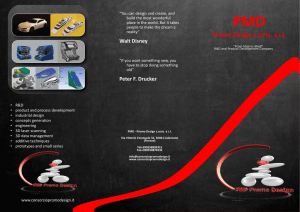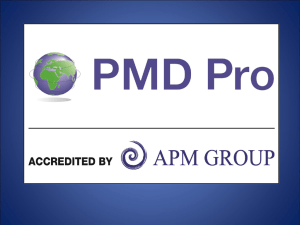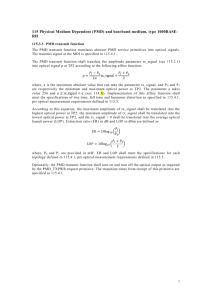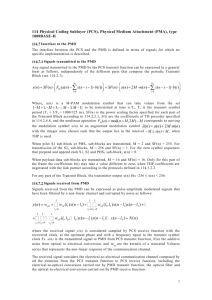PMD Pro Syllabus
advertisement
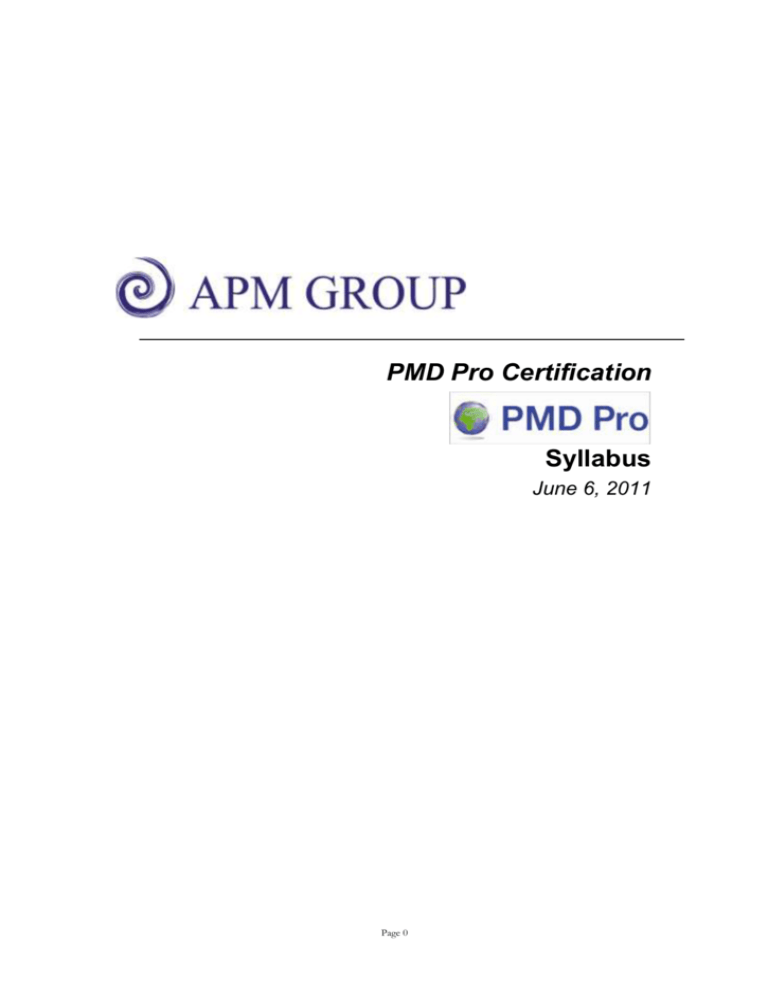
PMD Pro Certification Syllabus June 6, 2011 Page 0 1 Introduction The objective of this document is to identify the learning outcomes associated to the Guide to the PMD Pro. The syllabus informs the design of the exams PMD Pro Level 1 and PMD Pro Level 2 certifications. The syllabus provides training organizations a detailed breakdown of what the exams will assess. The syllabus provides exam candidates an overview of the learning objectives that need to be met before sitting the Level 1 and Level 2 examination. 2 PMD Pro1 Qualification 2.1 Purpose of the PMD Pro1 Qualification The purpose of the PMD Pro1 qualification is to confirm that a candidate has sufficient knowledge and understanding of the PMD Pro Guide to work as an informed member of a project team working within a development environment. The PMD Pro1 qualification is also a pre-requisite for the PMD Pro2 qualification. 2.2 Target Audience The PMD Pro1 is intended for an audience that includes: Project Managers and team members who are new to project management; Project Managers and team members who are new to the development sector; Development sector professionals who intend to pursue professional credentials in project management; Consultants/contract staff operating in the development sector. 2.3 High Level Performance Definition of a Successful PMD Pro1 Candidate To the PMD Pro1 will know and understand the content of the Guide to the PMD Pro. Specifically to: • • • • 3 3.1 Understand the context and content of projects in the development sector Know the principles, phases and disciplines of project management in the development sector context. Understand the relationship between principles, phases and disciplines within the development sector context. Understand the importance of adapting the PMD Pro to the context of the project. PMD Pro2 Qualification Purpose of the PMD Pro2 Qualification The purpose of the PMD Pro2 qualification is to confirm whether the candidate can analyse, apply and adapt the content of the PMD Pro in a development context 3.2 Target Audience The PMD Pro is intended for an audience that includes project managers and team members who have completed their PMD Pro1 certification and who are committed to pursuing professional credentials in project management. Candidates for the PMD Pro2 are also expected to complete (at minimum) an introductory level project management certification from an independent accreditation group. This could be the Project Management Institute’s CAPM, the OGC’s Prince2 Foundation, or any comparable accreditation. Note: While it is expected that PMD Pro2 candidates complete an additional non-PMD Pro professional project management accreditation, this is not a prerequisite for taking the PMD Pro2 examination. Page 1 3.3 High Level Performance Definition of a Successful PMD Pro2 Candidate The objective of this examination level is to measure whether a candidate can analyse and apply the content of the Guide to the PMD Pro in the context of a non-complex development project. Successful candidates will need to show they can analyse, apply and adapt the contents of the PMD Pro to address the challenges of a given project scenario. Specifically to: • Explain principles, phases and disciplines of PMD Pro management products as they apply to the particular circumstances of a given development project scenario. Demonstrate an understanding the relationships between principles, phases and disciplines of PMD Pro management products within the context of a given development project scenario. Demonstrate an understanding behind the principles, phases and disciplines of PMD Pro management products within the context of different development project scenarios. Demonstrate the ability to adapt the PMD Pro Management products to different development project environments. • • • 4 Learning Outcomes Assessment Model A classification widely used when designing assessments for certification and education is the Bloom’s Taxonomy of Educational Objectives. This classifies learning objectives into six ascending learning levels, each defining a higher degree of competencies and skills. (Bloom et al, 1956, Taxonomy of Educational Objectives). APMG have adapted this into a four-step variation of the Bloom’s model – The APMG Learning Outcomes Assessment Model which defines the standard for each qualification’s Learning Outcome Assessment Model. The Model is used as a basis for classifying learning outcomes when developing exam qualification schemes and syllabi. This structured approach helps to ensure: There is a clear delineation in learning level content between different qualification levels Learning outcomes are documented consistently across different manual areas Exam questions and papers are pitched consistently and appropriately for each of the learning levels. 4.1 PMD Pro Learning Outcome Assessment Model For the PMD Pro qualification the four levels of learning outcomes are shown below. These learning outcomes are independent of the method used to assess whether a qualification level has been achieved. PMD Pro Learning Outcomes Assessment Model 1.Knowledge Generic Definition from APMG Learning Outcomes Assessment Model 5 Know key facts, terms and concepts from the manual/guidance 2. Comprehension Understand key concepts from the manual/guidance 3. Application Be able to apply key concepts relating to the syllabus area for a given scenario 4. Analysis Be able to identify, analyse and distinguish between appropriate and inappropriate use of the PMD Pro Syllabus Presentation For each of the above learning levels, the syllabus defines the individual learning outcomes required for the qualification. Each learning outcome is then supported by a description of the requirements that a candidate is expected to meet to demonstrate that the learning outcome has been achieved at the qualification level indicated. These are shown as syllabus topics. Page 2 All PMD Pro1 level requirements are assumed to have been met for PMD Pro2 level and are not directly assessed again, although PMD Pro1 level knowledge and understanding will be used when demonstrating PMD Pro2 application and analysis learning outcomes. Each of the syllabus areas is presented in a similar format as follows: 1. Syllabus Area Unit of learning – e.g. a chapter of the manual/guidance document. 2. Learning Outcome A statement of what a candidate will be expected to know, understand or do. 3. Level Classification of the learning outcome against the APMG Learning Outcomes Assessment Model. 4 Topic Description of what is required of the candidate to demonstrate that a learning outcome has been achieved at the qualification level indicated 6 Syllabus Areas Syllabus Code Syllabus Area Title PR Projects in the Development Sector PM The PMD Pro Project Phase Model ID Project Identification and Design SU Project Set Up PP Project Planning PI Project Implementation ME Project Monitoring, Evaluation and Control EP End of Project Transition DO Project Management Disciplines – Overview SM Scope Management TM Time Management FM Financial Management RM Risk Management JM Project Justification Management SM Stakeholder Management SC Supply Chain Management AD Adapting the PMD Pro Page 3 Syllabus Area Code PR Syllabus Area : Projects in the Development Sector PMD Pro1 PMD Pro2 Level Topic Know fact, terms and concepts related to Projects in the Development Sector. 01 01 Define project management terms in the context of the international development context, including projects, programs, portfolios and project management. 01 02 Identify the three sides of the triple constraint triangle as defined in the PMD Pro 01 03 Recall the competencies of project managers in the development sector 01 04 Recall the responsibilities of project managers in the development sector Understand the Projects in the Development Sector topic 02 01 Explain how the culture of projects in the development sector differs from that in other sectors. 02 02 Map the skills and responsibilities of project managers in the development sector 02 03 Explain the relationship between the sides of a triple constraint triangle and its implications on project management. Be able to apply and tailor the Projects in the Development Sector to a scenario 03 01 Manage the performance of staff who have varying levels of competency levels in project management 03 02 Identify the advantages of managing a group of projects within the context of a program 03 03 Identify the skills development required as a project team member progresses from entry-level project manager to program manager. 03 04 Given a scenario in which project constraints are in flux, identify alternatives to manage the triple constraint triangle. Be able to identify, analyse and distinguish between appropriate and inappropriate application of the Projects in the Development Sector syllabus area to a scenario 04 01 Identify the differences in project management competencies required as the size, complexity and risk of a project scenario expands 04 02 Compare and contrast the content, purpose and process of projects, programs and portfolios in the international 04 03 Identify the implications of changes in project constraints on the management of the triple constraint triangle. Syllabus Area Code PM Level Syllabus Area : The PMD Pro Project Phase Model Primary Manual Reference 1.3, 1.4 1.3 1.6 1.3 1.2 1.6 1.3 1.6 1.4 1.6 1.3 1.6 1.4 1.3 PMD Pro1 PMD Pro2 Primary Manual Reference Topic Know fact, terms and concepts related to the PMD Project Phase Model. 01 01 Identify the six phases in the PMD Pro Project Phase Model. 2.2 01 02 Recall terms, facts and concepts related to the six phases of the generic project life cycle in the international development sector 2.2 Understand the PMD Pro Project Phase Model 02 01 02 02 02 03 02 04 Explain the ways that project phases in the PMD Pro Project Phase Model interact with each other. Explain the difference between Project Design, Monitoring and Evaluation and Project Management in the context of the international development sector. Understand the purpose and benefits of managing decision gates through the PMD Pro Project Life Cycle. Explain the importance of incorporating the principles of project management throughout the entire life of a project. 2.2 2.2 2.2 2.2 Be able to apply and tailor the PMD Pro Project Phase Model to a scenario 03 01 Ability to apply the six phases, tailoring the recommended activities and actions where appropriate, to a given project scenario Be able to identify, analyse and distinguish between appropriate and inappropriate application of the syllabus area the PMD Pro Project Phase Model to a scenario. Page 4 2.2 04 01 Syllabus Area Code ID Level Ability to evaluate the application of the six phases to a given project scenario, by assessing whether the relevant activities of the process were correctly applied Syllabus Area : Project Identification and Design 2.2 PMD Pro1 PMD Pro2 Primary Manual Reference Topic Know fact, terms and concepts related to the Project Identification and Design area. 01 01 Recall the three overarching categories of work in the Project Identification and Design Phase 2.2.1 01 02 Identify the purposes of data collection and data analysis 2.2.1.1, 2.2.2.2 01 03 Identify methodologies, approaches and tools for data collection 2.2.1.2 01 04 Identify methodologies, approaches and tools for data analysis 2.2.1.2 01 05 Identify the purposes of the logical framework 2.2.1.3 01 06 Define the 5 characteristics of a SMART indicator 2.2.1.3 01 07 Recall key project parameters described in the logical framework 2.2.1.3 01 08 Recall examples of decision gates in the life of a project 2.2.1.4 Understand the Project Identification and Design Phase 02 01 Explain the concept of diminishing opportunities to cost effectively manage change over the life of the project. 2.2.1 02 02 Identify differences between the four categories of social needs 2.2.1.1 02 03 Explain the importance of triangulation in the project identification and design phase 2.2.1.1 Identify differences between primary data (qualitative and quantitative) and secondary data. 2.2.1.1 02 04 02 05 Explain the categories of criteria that determine what is included in project interventions 2.2.1.2 02 06 Understand the vertical and horizontal logic of the project Logframe 2.2.1.3 02 07 Explain the benefits of managing decision gates in the context of project management. 2.2.1.4 Be able to apply and tailor Project Identification and Design Phase to a scenario 03 01 Select the most appropriate tool for the intended objectives of data collection and analysis 2.2.1.1, 2.2.1.2 03 02 Identify elements to include in project interventions based on clearly identified categories of decision criteria. 2.2.1.2 03 03 Given a scenario, use “go”/”no go” decision criteria to identify whether projects should be approved? 2.2.1.4 Be able to identify, analyse and distinguish between appropriate and inappropriate application of the syllabus area Project Identification and Design Phase to a scenario Specifically to: 04 01 Differentiate the advantages of each of the types of data collection 2.2.1.1 04 02 Compare and contrast the PMD Pro Logframe deliverables and indicators at each of the four levels. 2.2.1.3 04 03 Explain the variations in the opportunity to cost-effectively manage change through the life of a project 2.2.1 04 04 Given a project scenario, differentiate between the 4 categories of project need. 2.2.1.1 04 05 Interpret the vertical and horizontal logic of a logframe. 2.2.1.3 Page 5 04 06 Syllabus Area Code SU Level Assess the quality of project indicators based on the use of SMART criteria Syllabus Area : Project Set Up 2.2.1.3 PMD Pro1 PMD Pro2 Primary Manual Reference Topic Know fact, terms and concepts related to the Project Set Up area. 01 01 Know the objectives of the Project Set Up phase 2.2.2.1 01 02 Identify the three perspectives that should be represented in a project board. 2.2.2.2 01 03 Identify the purposes of project launch communications 2.2.2.4 Understand Project Set Up 02 01 Understand the purpose of the Project Charter 2.2.2.3 02 02 Explain the importance of establishing a project governance structure 2.2.2.2 02 03 Explain the responsibilities of a project sponsor and a project board 2.2.2.2 02 04 Explain the connection between project tolerances and project governance 2.2.2.1 Be able to apply and tailor Project Set Up to a scenario 03 01 Based on a project scenario, create or update a Project Charter. 2.2.2.3 03 02 Based on a project scenario, identify strategies to improve project performance through improved project governance processes. 2.2.2.2 Be able to identify, analyse and distinguish between appropriate and inappropriate application of the syllabus area Project Set Up] to a scenario 04 01 Syllabus Area Code PP Level Ability to evaluate the application of the Project Set Up Phase actions when provided a project scenario Syllabus Area Project Planning 2.2.2 PMD Pro1 PMD Pro2 Primary Manual Reference Topic Know fact, terms and concepts related to the Project Planning area. 2.2.3 01 01 Recall facts terms and concepts related to the importance and timing of the project implementation plan. 01 02 Identify the eight components of a comprehensive project plan. 2.2.3.3 01 03 Identify the advantages of developing project plans through a participatory process 2.2.3.5 Understand the Project Planning Phase Specifically to: 02 01 Explain the importance of incorporating each of the PMD Pro project management principles into the project planning process 02 02 Understand the advantages of iterative, rolling wave planning 02 03 Compare and contrast project log frames, concept papers, proposals and implementation plans 2.2.3.2 -2.2.3.6 2.2.3.6 2.2.3 Be able to apply and tailor Project Planning Phase to a scenario Specifically to: 03 01 Identify scenarios where a rolling wave approach to project planning should be used. 03 02 Based on project scenarios, identify the strengths and weaknesses of project plan in terms of balance, comprehensiveness, integration, participation and iteration. Page 6 2.2.3.6 2.2.3.2 – 2.2.3.6 Be able to identify, analyse and distinguish between appropriate and inappropriate application of the syllabus area of Project Planning to a scenario Specifically to: 04 01 Compare and contrast the purpose of the Logical Framework, the Project Proposal and the Project Implementation Plan in terms of purpose, content, audience and process. 2.2.3.3 04 02 Explain the relationship between the project discipline areas and a comprehensive project plan. 2.2.3.3 04 03 Explain the relationship between the project constraint triangle and an integrated project plan. 2.2.3.4 Syllabus Area Code PI Level Syllabus Area : Project Implementation PMD Pro1 PMD Pro2 Primary Manual Reference Topic Know fact, terms and concepts related to the Project Implementation Phase area. 01 01 Define terms related to project implementation, including Issues, Issues logs, and internal controls 2.2.4.1 – 2.2.4.3 01 02 Identify the four basic processes In the issue management process 2.2.4.1 01 03 Identify the activities conducted to manage people during project implementation 2.2.4.2 Understand Project Implementation Phase 02 01 Understand the importance of issue management in the implementation of development projects. 2.2.4.1 02 02 Explain the sequence and relationship between the four basic processes of issues management 2.2.4.1 02 03 Identify the benefits of well-managed internal control systems 2.2.4.3 Be able to apply and tailor the Project Planning Phase to a scenario 03 01 Develop an issues log based on a project scenario 2.2.4.1 03 02 Apply a four-step process to issue management in a project scenario 2.2.4.1 Be able to identify, analyse and distinguish between appropriate and inappropriate application of the syllabus area of Project Planning to a scenario 04 01 Syllabus Area Code ME Level Identify alternatives for internal control systems based on categories of administrative, financial and logistic systems Syllabus Area : Project Monitoring, Evaluation and Control 2.2.4.3 PMD Pro1 PMD Pro2 Primary Manual Reference Topic Know fact, terms and concepts related to Project Monitoring, Evaluation and Control 01 01 Recall the facts, terms and concepts related to the levels of project monitoring/evaluation and their connection to the project logical framework. 2.2.5.1 – 2.2.5.3 01 02 Recall facts terms and concepts related to different evaluation approaches 2.2.5.2 01 03 Recall facts, terms and concepts related to the project monitoring and evaluation plan 2.2.5.3 01 04 Recall facts, terms and concepts related to change control management 2.2.5.2 Understand the Project Monitoring, Evaluation and Control Phase 02 01 Identify the six elements of a project monitoring system 2.25.2 02 02 Identify the six areas of project tolerances 2.2.5.5 Page 7 02 03 Explain the tradeoff between cost and complexity when collecting monitoring data 2.2..5.2 Be able to apply and tailor Project Monitoring, Evaluation and Control Phase to a scenario 03 01 Explain the importance of the project monitoring plan and how its content differs from that contained in the project log frame and project plan. 2.2.5.2 03 02 Understand the elements that should inform the project monitoring and evaluation plan 2.2.5.2 03 03 Explain the reasons to evaluate projects 2.2.5.3 Be able to identify, analyse and distinguish between appropriate and inappropriate application of the Project Monitoring, Evaluation and Control syllabus area 04 01 Compare and contrast the content, process and purpose of quantitative and qualitative indicators 2.2.5.2 04 02 Compare and contrast the cost and complexity of different monitoring approaches 2.2.5.2 04 03 Compare differences between project monitoring, project evaluation and project control. 2.2.5.1 04 04 Explain the relationship between project monitoring and evaluation and an iterative planning process. 2.2.5.1 04 05 Differentiate between monitoring and evaluation indicators at different levels of the project logical framework 2.2.5.1 Syllabus Area Code EP Level Syllabus Area : End of Project Transition PMD Pro1 PMD Pro2 Primary Manual Reference Topic Know fact, terms and concepts related to the End of Project Transition Phase area. 01 01 Recall the 4 options for project transition 2.2.6.1 01 02 Recall activities related to the administrative, contract and financial closure of projects 2.2.6.3 01 03 Identify the two-step process for verifying project deliverables. 2.2.6.2 Understand the End of Project Transition Phase 02 01 Differentiate between project After Action Reviews and end of project evaluations 2.2.6.4 02 02 Explain the purpose and contents of a Project Transition Planning Matrix 2.2.6.1 Be able to apply and tailor the End of Project Transition Phase to a scenario 03 01 Develop an end of project transition strategy 2.2.6.1 03 02 Choose between the best tools to collect end-of-project learning based on project constraints and learning objectives. 2.2.6.4 Be able to identify, analyse and distinguish between appropriate and inappropriate application of the syllabus area of the End of Project Transition Phase to a scenario 04 01 Distinguish between the appropriate and inappropriate application of administrative, contract and financial closure of a project. 2.2.6.4 04 02 Compare and contrast the different options for end of project learning 2.2.6.5 04 03 Distinguish between the appropriate and inappropriate application of administrative, contract and financial closure. 3.3.6.4 Syllabus Area Code DO Level Syllabus Area : Project Management Disciplines Overview PMD Pro1 Topic Page 8 PMD Pro2 Primary Manual Reference Know fact, terms and concepts related to the syllabus area. 01 01 Know the seven project management disciplines. 3.0 Understand the Project Management Disciplines Overview topic. 02 01 Understand how the PMD Pro project cycle is supported by the seven project management disciplines. 3.0 02 02 Explain how the seven disciplines can be applied within the PMD Pro project cycle. 3.0 Be able to apply and tailor the Project Management Disciplines Overview topic to a scenario 03 01 Ability to apply the seven disciplines to a given project scenario. 3.0 Be able to identify, analyse and distinguish between appropriate and inappropriate application of the Project Management Disciplines Overview topic to a scenario 04 01 Syllabus Area Code SM Level Ability to evaluate the application of the seven disciplines to a given project scenario. Syllabus Area : Scope Management 3.0 PMD Pro1 PMD Pro2 Primary Manual Reference Topic Know fact, terms and concepts related to Scope Management. 01 01 Recall the facts, terms and concepts related to scope management, including product scope, project scope, and WBS 3.1.1 – 3.1.2 01 02 Identify the benefits of work breakdown structure 3.1.2 Understand Scope Management 02 01 Understand the difference between product scope and project scope. 3.1.1 02 02 Understand that the scope of the project must be confirmed and must be comprehensive and detailed. 3.1.1 02 03 Understand the three most common problems that arise from the absence of a clearly defined scope 3.1.1 02 04 Understand the composition of a WBS (work breakdown structure). 3.1.2 02 05 Explain the advantages of the two WBS formats. 3.1.2 Be able to apply and tailor Scope Management to a scenario 03 01 Produce a simple work breakdown structure to a given project scenario in an indented format. 3.1.2 03 02 Ability to produce a simple work breakdown structure to a given project scenario in a graphic diagram format. 3.1.2 Be able to identify, analyse and distinguish between appropriate and inappropriate application of Scope Management to a scenario 04 01 Explain comprehensive and detailed product and project scope through the use of a given project scenario. 3.1.1 04 02 Evaluate a work breakdown structure in terms of comprehensiveness and detail for a given project scenario. 3.1.2 Syllabus Area Code TM Level Syllabus Area : Time Management PMD Pro1 PMD Pro2 Primary Manual Reference Topic Know fact, terms and concepts related to Time Management 01 01 Know the 5 steps in schedule planning. 3.2.0 Page 9 01 02 Define terms related to time management, including network diagrams, critical paths, Gantt chart, project float, fast tracking and crashing. 3.2.1-3.2.5 Understand Time Management 02 01 Understand the five steps to the schedule planning process: 3.2.0 02 02 Explain the relationship between resource estimating and calendar development 3.2.2 – 3.2.3 02 03 Understand the relationship between the project constraint triangle and schedule development 3.2..0 02 04 Understand the purpose, structure and content of a Gantt chart. 3.2.4 02 05 Understand the purpose, structure and content of a network diagram 3.2.1 02 06 Explain the purpose and process of crashing and fast tracking 3.2.5 Be able to apply and tailor Time Management to a scenario 03 01 Ability to construct a simple network diagram, given a project scenario. 3.2.1 – 3.2.4 03 02 Ability to construct a simple Gantt chart, given a project scenario. 3.2.4 03 03 Ability to identify potential project duration factors in a given project scenario. 3.2.3 03 04 Ability to identify a project’s critical path in a given network diagram for a given project scenario. 3.2.3 Be able to identify, analyse and distinguish between appropriate and inappropriate application of Time Management to a scenario 04 01 Discriminate which tasks from a given network diagram are part of a project’s critical path versus those that are project float or slack 3.2.3 04 02 Ability to explain when a Summary Gantt Chart is used versus a Gantt chart. 3.2.4 04 03 Identify opportunities to manage late projects through crashing and fast tracking. 3.2.5 Syllabus Area Code FM Level Syllabus Area : Financial Management PMD Pro1 PMD Pro2 Primary Manual Reference Topic Know fact, terms and concepts related to Financial Management. 01 01 Define the terms related to financial management, including direct costs, indirect costs, transaction costs, shared services, chart of accounts, variance and earned value analysis 3.3.1 – 3.3.3 01 02 Define the three approaches to making project estimates 3.3.2 Understand Financial Management 02 01 Explain the advantage of developing budget phase estimates. 3.3.2 02 02 Understand the advantages and disadvantages of the three estimation techniques 3.3.2 02 03 Explain the importance of monitoring cash flow 3.3.3 02 04 Understand the meaning of earned value analysis 3.3.3 Be able to apply and tailor Financial Management scenario 03 01 Ability to construct a simple budget 3.3.1 03 02 Explain the process of measuring Earned Value. 3.3.3 03 03 Explain the purpose and construct of a Chart of Accounts 3.3.1 03 04 Given a project scenario, select between estimates based on Top-down, Bottom-up and parametric data 3.3.2 Page 10 Be able to identify, analyse and distinguish between appropriate and inappropriate application of Financial Management to a scenario 04 01 Ability to evaluate the application of developing a budget for a given project scenario 3.3.1 04 02 Identify the advantages of Earned Value Analysis 3.3.3 04 03 Given budget data, analyze the cumulative cost variance of a project. 3.3.3 04 03 Given budget and calendar data, analyze the earned value status of a project 3.3.3 Syllabus Area Code RM Level Syllabus Area : Risk Management PMD Pro1 PMD Pro2 Primary Manual Reference Topic Know fact, terms and concepts related to Risk Management. 01 01 Identify the four-step risk management process 3.4.0 01 02 Define terms related to risk management, including positive risks, negative risks, risk register, risk assessment matrix and risk tolerances 3.4.1 - 3.4.4 01 03 Identify the four risk response strategies. 3.4.3 Understand Risk Management 02 01 Explain the significance of probability and impact in the context of risk management. 3.4.2 02 02 Explain the iterative nature of risk management and its importance throughout the entire life of the project. 3.4.4 02 03 Understand the content and structure of a risk register 3.4.1 02 04 Explain the purpose, structure and content of a Risk Assessment Matrix 3.4.2 Be able to apply and tailor Risk Management to a scenario 03 01 Apply the Risk Assessment Matrix to a given project scenario. 3.4.2 03 02 Organize project risks by risk category 3.4.1 03 03 Ability to apply the four risk management strategies in case-based scenarios. 3.4.1 – 3.4.4 Be able to identify, analyse and distinguish between appropriate and inappropriate application of Risk Management to a scenario 04 01 Interpret a risk assessment matrix to differentiate risks that can be tolerated versus risks that can be eliminated in a given non-complex project scenario. 3.4.2 04 02 Categorize risk response strategies 3.4.3 04 03 Interpret the contents of a risk register 3.4.1 Syllabus Area Code JM Level Syllabus Area : Justification Management PMD Pro1 PMD Pro2 Primary Manual Reference Topic Know fact, terms and concepts related to the syllabus area. 01 01 Define the terms related to project justification management:, including problem-based needs identification, asset-based needs identification, problem trees and objective trees 3.5.1 – 3.5.2 Understand Justification Management 02 01 Understand the importance of project justification to the project team as well as the project stakeholders Page 11 3.5.0 02 02 Differentiate between “problem-based” approaches an “assets-based approaches” to needs identification 3.5.1 02 03 Understand the relationship between a problem tree and an objective tree 3.5.2 02 04 Identify and explain the levels of hierarchy in the problem tree process 3.5.2 Be able to apply and tailor Justification Management to a scenario 03 01 Create a basic problem tree given a project scenario 3.5.2 03 02 Create an objectives tree based on a given problem tree 3.5.2 03 03 Determine how proposed project intervention objectives meet the project justification criteria in a given project scenario 3.5.2 Be able to identify, analyse and distinguish between appropriate and inappropriate application of Justification Management to a scenario 04 01 Ability to evaluate if there is adequate justification for a project intervention based on a need-based approach to proposed problems to a project 3.5.2 04 02 Interpret the cause and effect relationships in a problem tree 3.5.2 Compare and contrast the problem-based approaches to assets-based approaches to needs identification 3.5.1 Syllabus Area Code SM Level Syllabus Area : Stakeholder Management PMD Pro1 PMD Pro2 Primary Manual Reference Topic Know fact, terms and concepts related to Stakeholder Management 01 01 List the six categories of stakeholders 3.6.1 01 02 Know the components of a RACI chart. 3.6.3 01 03 Know that communication to the Stakeholders is essential and requires planning and execution. 3.6.4 01 04 Recall tools used to identify stakeholders in terms of project dependency, risk and power 3.6.2 Understand Stakeholder Management 02 01 Understand the four key roles identified in a RACI chart: 3.6.3 02 02 Understand the components of a communication plan. 3.6.4 02 03 Explain the purpose and construct of stakeholder analysis tools, including RACI Charts, Venn diagrams, stakeholder analysis matrices and communications plans 3.6.1 – 3.6.4 Be able to apply and tailor Stakeholder Management to a scenario 03 01 Categorize groups of stakeholders in a given project scenario 3.6.1 03 02 Construct a Venn diagram from a given project scenario 3.6.2 03 03 Construct a RACI matrix from a given project scenario 3.6.3 03 04 Construct a Stakeholder Analysis Matrix for a given project scenario 2.6.2 03 05 Apply the recommended components to a communication plan in a given project scenario 3.6.4 Be able to identify, analyse and distinguish between appropriate and inappropriate application of Stakeholder Management to a scenario Specifically to: 04 01 Interpret the content of the stakeholder management tools, including the RACI Chart, Venn Diagram, the Stakeholder Analysis Matrix and the Communications Plan Page 12 3.6.1 – 3.6.4 Syllabus Area Code SC Level Syllabus Area : Supply Chain Management PMD Pro1 PMD Pro2 Primary Manual Reference Topic Know fact, terms and concepts related to the Supply Chain Management. 01 01 Identify the four components that comprise supply chain management 3.7.0 01 02 Identify the four steps in procurement management 3.7.1 Understand Supply Chain Management. 02 01 Explain the 4 elements of logistics management: 3.7.2 02 02 Identify alternatives for identifying providers in the procurement process 3.7.1 Be able to apply and tailor Supply Chain Management to a scenario 03 01 3.7.1 – 3.7.4 Ability to apply the principles of Supply Chain Management to a given project scenario. Be able to identify, analyse and distinguish between appropriate and inappropriate application of Supply Chain Management to a scenario 04 01 Syllabus Area Code AD Level Ability to evaluate, using the recommended content, the use of the following supply chain processes in a given project scenario: procurement management; logistics management; asset management; and information management Syllabus Area : Adapting the PMD Pro 3.7.1 – 3.7.4 PMD Pro1 PMD Pro2 Primary Manual Reference Topic Know fact, terms and concepts related to the Adapting the PMD Pro syllabus area. 01 01 Recall the principles of adaption 4.1 Understand the Adapting the PMD Pro syllabus area. 02 01 Understand factors to consideration when adapting PMD Pro to projects 4.4 02 02 Understand the role of systems in adapting PMD Pro tools and techniques 4.4 02 03 Understand the relationship between a project’s risk profile and the choice of PMD Pro tools and techniques 4.4 02 04 Appreciate the considerations needed when implementing projects using PMD Pro through implementing partners 4.4 Be able to apply and tailor the Adapting the PMD Pro area to a scenario 03 01 Adapt the PMD Pro Disciplines to individual project scenarios 4.1 – 4.4 03 02 Make recommendations to apply PMD Pro principles to programs and the wider organization 4.1 – 4.4 Be able to identify, analyse and distinguish between appropriate and inappropriate application of the syllabus area to a scenario 04 01 Interpret applications of PMD Pro tools and techniques to specific project 4.1 – 4.4 04 02 Link PMD Pro tools and techniques to business processes 4.4 Page 13
